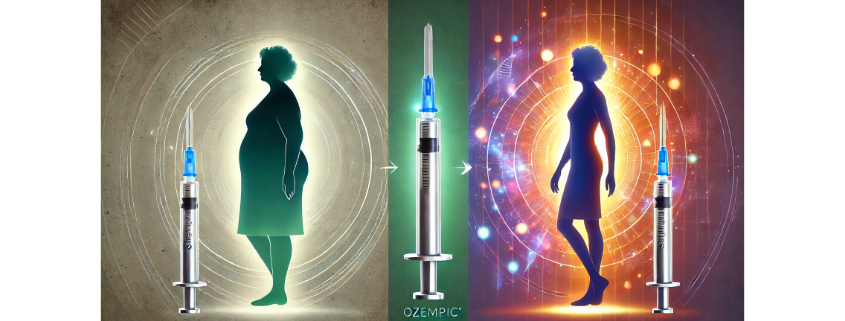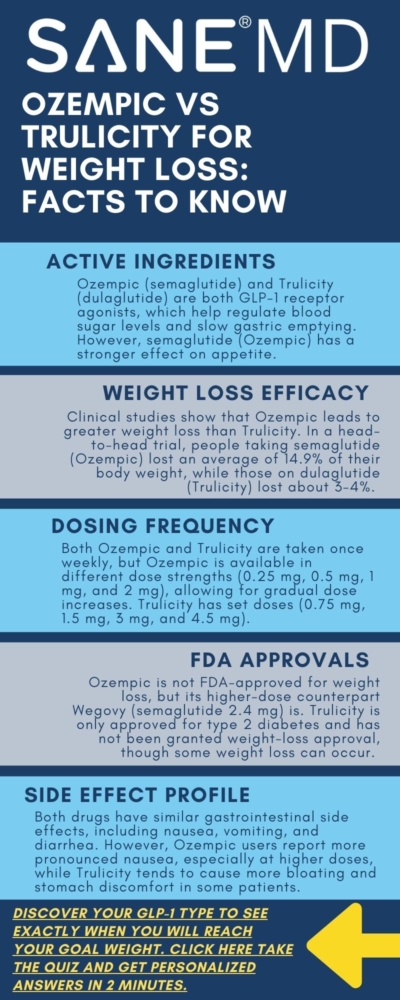Ozempic vs Trulicity for Weight Loss: Which Works Better?
Dr. Matthew Olesiak, MD, is the Chief Medical Director at SANESolution, a renowned wellness technology company dedicated to providing evidence-based solutions for optimal living. Dr. Olesiak earned his medical degree from the prestigious Jagiellonian University Medical College in Kraków, Poland, where he developed a strong foundation in medicine.

Ozempic and Trulicity are two popular GLP-1 medications (receptor agonists) used to manage type 2 diabetes and promote weight loss for certain individuals. While both medications help control blood sugar levels, they have distinct differences that can influence a doctor’s recommendation. But when it comes to Ozempic vs Trulicity for weight loss, which one is more effective?
In this article, we will compare Trulicity and Ozempic based on clinical trials, side effects, and potential health benefits. We will also discuss how these medications fit into diabetes management and weight loss plans.
Key Takeaways
- Both Ozempic and Trulicity belong to the same drug class and are FDA-approved for managing type 2 diabetes.
- Ozempic appears to be more effective for losing weight, while Trulicity may have advantages in heart health benefits. (Some GLP-1 drugs have been shown to boost weight loss and improve heart health.)
- Choosing between the two depends on treatment goals, health history, and insurance coverage.
Ozempic and Trulicity: Understanding the Basics
Both Ozempic and Trulicity belong to the class of GLP-1 receptor agonists, a group of diabetes medications that help manage type 2 diabetes and promote weight loss by mimicking the glucagon-like peptide-1 (GLP-1) hormone. (See our GLP-1 Medications list for a complete rundown of options.) This hormone is naturally produced in the gut and plays a crucial role in blood sugar control, appetite regulation, and digestion.
These medications work through three primary mechanisms:
- Stimulating Insulin Release: They trigger the pancreas to release insulin in response to blood glucose levels, helping to lower blood sugar levels after meals.
- Delaying Gastric Emptying: They slow down the movement of food from the stomach to the small intestine, leading to prolonged satiety and reduced appetite, which contributes to losing weight.
- Reducing Glucagon Secretion: Glucagon is a hormone that raises blood sugar by prompting the liver to release stored glucose. By suppressing this process, GLP-1 receptor agonists help maintain stable blood glucose levels.
Active Ingredients and How They Work
Although Ozempic and Trulicity are both GLP-1 therapies that belong to the same drug class, they contain different active ingredients, which influence their effectiveness, average weight loss, and treatment goals.
Ozempic (Semaglutide)
- Dosing: Available in 0.5 mg, 1 mg, and 2 mg strengths.
- Administration: Injected once weekly in the upper arm, thigh, or abdomen.
- Weight Loss Effects: Clinical trials indicate that Ozempic compares favorably to Trulicity for weight reduction, with higher weight loss efficacy for certain individuals.
- FDA Approval: Originally FDA-approved for managing type 2 diabetes, but a higher dose version (Wegovy) has received FDA approval for weight loss.
- Additional Benefits: Helps lower blood sugar, supports heart health benefits, and reduces the risk of cardiovascular problems.
Trulicity (Dulaglutide)
- Dosing: Available in 0.75 mg, 1.5 mg, 3 mg, and 4.5 mg doses.
- Administration: Injected once weekly in the upper arm, thigh, or abdomen.
- Weight Loss Effects: Both Trulicity and Ozempic promote weight loss, but in clinical trials, Trulicity has shown less weight loss than Ozempic.
- FDA Approval: Approved for type 2 diabetes management but not officially approved for weight loss.
- Cardiovascular Benefits: Often prescribed for its heart health benefits, particularly in patients with a history of heart disease or cardiovascular problems.
Both medications work to lower blood sugar levels and are FDA-approved for adults with type 2 diabetes, but they differ in their effectiveness for losing weight. While Ozempic tends to result in higher average weight loss, Trulicity may be preferred for patients prioritizing heart health benefits.
Your doctor prescribes the appropriate medication based on treatment goals, health history, and other factors, such as insurance coverage and individual response to the drug.
Trulicity vs Ozempic: Which is More Effective for Weight Loss?
Both Trulicity and Ozempic help lower blood sugar levels and aid in weight loss, but research suggests that Ozempic is generally more effective. While both medications belong to the same drug class, their differences in active ingredients, dosing, and mechanism of action influence their effectiveness in reducing body weight for compatible individuals.
Weight Loss Results from Clinical Trials
Numerous clinical trials have evaluated Trulicity vs Ozempic for weight loss in adults with type 2 diabetes. The research shows that Ozempic leads to significantly greater reductions in body weight compared to Trulicity.
- A study in Lancet Diabetes & Endocrinol (2021) compared Trulicity vs Ozempic in overweight adults with type 2 diabetes. Patients using Ozempic 0.5 mg or higher experienced more significant weight loss than those taking Trulicity. On average, individuals on Ozempic lost 10-15 pounds, whereas those on Trulicity lost about 6-8 pounds (Lancet Diabetes Endocrinol, 2021).
- Another trial published in Diabetes Care (2022) examined a higher dose version of Ozempic (2.4 mg), which is marketed under Wegovy for weight management. The trial found that participants lost an average of 14.9% of their body weight, while those taking Trulicity lost only 6-8% of their body weight (Diabetes Care, 2022). This suggests that higher doses of semaglutide (Ozempic’s active ingredient) can enhance weight loss outcomes beyond what is seen with Trulicity.
- A study published in the New England Journal of Medicine (NEJM) reported that Ozempic (semaglutide) at a 1 mg or 2 mg dose produced greater weight loss compared to Trulicity (dulaglutide) at 1.5 mg or 3 mg doses. Patients taking Ozempic lost between 8-12% of their body weight, while those on Trulicity lost 4-6% (NEJM, 2021).
However, it should be noted that a certain percentage of muscle loss is also common with these drugs. See our guide titled “Do GLP-1 Drugs Cause Muscle Loss” for an in-depth exploration of this topic.
Why is Ozempic More Effective for Weight Loss?
There are several reasons Ozempic appears to be more effective than Trulicity for losing weight:
✅ Stronger Appetite Suppression: Ozempic binds more effectively to GLP-1 receptors, leading to a longer duration of action and enhanced appetite reduction.
✅ Higher Maximum Dose: Ozempic’s maximum dose (2 mg or 2.4 mg in Wegovy) is higher than Trulicity’s 4.5 mg dose, allowing for greater weight loss benefits.
✅ Longer Half-Life: Semaglutide (Ozempic) stays in the body longer than dulaglutide (Trulicity), meaning its effects on gastric emptying and appetite suppression last longer.
✅ Directly Compared in Clinical Trials: In head-to-head clinical trials, Ozempic consistently outperformed Trulicity in average weight loss and body weight reduction.
Dr. Matthew Olesiak, MD, Chief Medical Director at SANE MD, explains:
“Ozempic has demonstrated superior weight loss effects compared to Trulicity, primarily due to its stronger appetite suppression and increased duration of action.”
Thus, if losing weight is the primary goal, Ozempic appears to be the more effective choice. However, both Trulicity and Ozempic have their own benefits depending on individual treatment goals, health history, and other factors such as heart disease risk and insurance coverage.
Key Differences Between Ozempic and Trulicity
| Feature | Ozempic (Semaglutide) | Trulicity (Dulaglutide) |
|---|---|---|
| Dosing | 0.5 mg, 1 mg, 2 mg | 0.75 mg, 1.5 mg, 3 mg, 4.5 mg |
| Average Weight Loss | Up to 14.9% | 6-8% |
| Blood Sugar Control | Strong | Moderate |
| FDA Approval | FDA-approved for diabetes | FDA-approved for diabetes |
| Heart Health Benefits | Reduces cardiovascular death risk | May offer more protection against heart disease |
| Side Effects | Gastrointestinal adverse reactions (nausea, diarrhea) | Less nausea but more injection site reactions |
| Maximum Dose | 2 mg | 4.5 mg |
Side Effects and Safety Considerations
Both Trulicity and Ozempic are effective medications for type 2 diabetes and weight loss, but they also come with potential side effects and safety considerations. The most commonly reported side effects involve gastrointestinal adverse reactions, though serious health risks may also be present in some patients.
Common Side Effects
The most frequent side effects of both Trulicity and Ozempic occur in the digestive system and are typically dose-dependent. This means they are more likely to occur at higher doses or when the medication is first started.
- Abdominal pain – Patients often report mild to moderate stomach discomfort, which may improve over time.
- Upset stomach – Symptoms such as bloating, cramping, and nausea are common.
- Gastrointestinal adverse reactions – These include nausea, diarrhea, vomiting, and constipation, which may subside as the body adjusts to the medication.
- Delayed gastric emptying – Both Ozempic and Trulicity slow digestion, which can cause fullness, acid reflux, or bloating after meals.
- Injection site reactions – Some individuals experience redness, itching, or swelling at the injection site in the upper arm, thigh, or abdomen.
In most cases, these side effects lessen over time as the body adjusts to the medication. However, persistent or severe symptoms should be reported to a doctor.

Serious Risks and Warnings
While Trulicity and Ozempic are generally safe, there are serious risks associated with their use. Patients with certain health conditions or family history of certain diseases should discuss these risk factors with their healthcare provider before starting treatment.
Thyroid C-Cell Tumors and Thyroid Cancer
- Both medications carry an FDA-mandated boxed warning for an increased risk of thyroid C-cell tumors in animal studies.
- While human cases are rare, patients with a family history of medullary thyroid cancer (MTC) or multiple endocrine neoplasia syndrome type 2 (MEN 2) should avoid GLP-1 receptor agonists.
- Symptoms of thyroid cancer to watch for include lumps or swelling in the neck, difficulty swallowing, and hoarseness.
Diabetic Retinopathy
- Patients with type 2 diabetes are already at risk for diabetic retinopathy, a condition that affects vision due to damaged blood vessels in the eyes.
- Clinical trials have linked Ozempic to a possible worsening of diabetic retinopathy, particularly in patients with pre-existing eye disease.
- Regular eye exams are recommended for those at risk.
Acute Kidney Injury and Chronic Kidney Disease
- Both Trulicity and Ozempic can affect kidney function, especially in patients with chronic kidney disease (CKD).
- Acute kidney injury can occur due to dehydration from excessive vomiting or diarrhea.
- Patients should monitor kidney function through routine blood tests and ensure they remain well-hydrated.
Gallbladder Problems and Pancreatitis
- Studies suggest that GLP-1 receptor agonists can increase the risk of gallstones and gallbladder problems.
- Symptoms such as upper abdominal pain, nausea, and jaundice (yellowing of the skin or eyes) may indicate gallbladder disease.
- There is also a potential increased risk of pancreatitis, which presents with severe abdominal pain radiating to the back, nausea, and vomiting.
Cardiovascular Risks and Heart Disease
- While both Ozempic and Trulicity have heart health benefits, some patients may experience cardiovascular problems, including fluctuations in blood pressure and heart rate.
- Clinical trials suggest Ozempic may help reduce the risk of cardiovascular death, but patients with pre-existing heart disease should be monitored for changes in heart function.
Potential for Allergic Reactions
- Severe allergic reactions to GLP-1 receptor agonists are rare but can occur.
- Symptoms may include rash, swelling, difficulty breathing, or anaphylaxis.
- Patients should seek immediate medical attention if they experience severe allergic reactions.
Who Should Avoid Trulicity and Ozempic?
Not all patients are suitable candidates for GLP-1 receptor agonists. Both Trulicity and Ozempic may not be recommended for individuals with:
- A history of medullary thyroid cancer (MTC) or MEN 2.
- Severe gastrointestinal disorders, including gastroparesis.
- A history of pancreatitis or gallbladder problems.
- Advanced kidney disease or acute kidney injury risk.
- Severe cardiovascular problems that may be worsened by fluctuations in heart rate or blood pressure.
Dr. Matthew Olesiak, MD, Chief Medical Director at SANE MD, advises:
“Although both medications are effective, patients should discuss potential risk factors like kidney function, health history, and preexisting cardiovascular problems with their doctor before starting treatment.”
Switching from Trulicity to Ozempic
Many patients consider switching from Trulicity to Ozempic due to greater weight loss, better blood sugar control, or a change in treatment goals. Since Trulicity and Ozempic belong to the same drug class of GLP-1 receptor agonists, transitioning from one medication to the other is possible, but it must be done carefully to minimize side effects and ensure a smooth adjustment.
Before switching, it is crucial to consult with a healthcare provider who can assess factors such as treatment goals, blood glucose levels, heart disease risk, and kidney function. The doctor will evaluate the patient’s health history and determine the safest approach for transitioning between these medications.
How to Switch Medications
Switching from Trulicity to Ozempic should be done under the guidance of a doctor to reduce the risk of side effects, including gastrointestinal adverse reactions, blood sugar fluctuations, and allergic reactions.
- Start with a Lower Blood Sugar Dose of 0.5 mg Ozempic
- The starting dose of Ozempic is typically 0.5 mg once weekly to allow the body to adjust.
- Patients should not start at the maximum dose, as doing so increases the risk of nausea, diarrhea, and vomiting.
- If needed, the dose may be increased gradually to 1 mg or 2 mg based on treatment goals.
- Monitor for Allergic Reactions or Side Effects
- Patients should watch for common side effects, including abdominal pain, nausea, upset stomach, and delayed gastric emptying.
- Signs of an allergic reaction, such as swelling, rash, or difficulty breathing, require immediate medical attention.
- Blood tests may be needed to check for any impact on kidney function or gallbladder problems.
- Adjust Based on Treatment Goals
- A doctor may adjust the Ozempic dose depending on whether the primary goal is to lower blood sugar levels or lose weight.
- If weight loss is the priority, a higher dose version (such as 2.4 mg Wegovy) may be considered.
- Patients with heart disease may need additional monitoring to ensure cardiovascular benefits are maintained.
Important Considerations When Switching
✔ Timing Between Doses: There should be no overlap between Trulicity and Ozempic. The first Ozempic dose should be taken one week after the last Trulicity injection.
✔ Adjusting to a New Drug: Since Ozempic has a longer half-life than Trulicity, patients may take a few weeks to feel the full effects.
✔ Potential Insurance Coverage Changes: Health insurance may cover one medication but not the other. Checking insurance coverage before switching can help avoid unexpected costs.
✔ Regular Follow-Ups with a Healthcare Provider: Blood sugar levels should be closely monitored, especially in the first few weeks after switching. Patients with diabetic retinopathy, chronic kidney disease, or high blood pressure should schedule follow-up visits to assess any changes in their condition.
Since both Trulicity and Ozempic belong to the same drug class, most patients tolerate the switch well, but individual responses vary. A doctor’s guidance is essential to ensure a safe and effective transition while minimizing potential risks.
Insurance Coverage and Cost Comparison
The cost of both Trulicity and Ozempic varies based on health insurance and pharmacy pricing.
Factors Affecting Cost
- Insurance coverage: Some plans cover one but not the other.
- Doctor prescribes a higher dose version, which may cost more.
- Other factors like location and manufacturer discounts.
Frequently Asked Questions (FAQ) About Ozempic and Trulicity
Both Ozempic and Trulicity are GLP-1 receptor agonists that help with type 2 diabetes management and weight loss. However, they have different effects on blood sugar control, average weight loss, and side effects.
Below are answers to common questions about these medications, including their effectiveness, switching between them, and availability.
1. Do You Lose More Weight with Ozempic or Trulicity?
Clinical studies show that Ozempic is more effective than Trulicity for losing weight. Research published in Lancet Diabetes & Endocrinol found that patients taking Ozempic 0.5 mg or higher lost significantly more weight than those on Trulicity. In another trial, Ozempic 2.4 mg (marketed as Wegovy) resulted in an average weight loss of 14.9% of body weight, while Trulicity led to 6-8% weight loss.
The difference is likely due to Ozempic’s more potent appetite suppression and longer duration of action, which help patients feel full for longer. However, individual results vary, and a doctor prescribes the best option based on a patient’s treatment goals and health history.
2. Can You Just Switch from Trulicity to Ozempic?
Yes, many patients switch from Trulicity to Ozempic, but this should be done under a doctor’s guidance. Since both Trulicity and Ozempic belong to the same drug class, transitioning is generally safe, but differences in dosing and potency mean adjustments may be necessary. Most healthcare providers recommend starting with a lower blood sugar dose of Ozempic 0.5 mg once weekly and monitoring for side effects such as gastrointestinal adverse reactions.
Patients should wait one week after their last Trulicity dose before beginning Ozempic to avoid overlapping effects. Close monitoring of blood sugar levels, kidney function, and weight loss progress is essential during the transition.
3. Why is Trulicity No Longer Available?
Trulicity is still available and FDA-approved for treating type 2 diabetes, but in some regions, it may be temporarily out of stock due to supply chain issues or increased demand. Additionally, newer GLP-1 receptor agonists like Ozempic and Mounjaro have gained popularity due to their higher weight loss efficacy and longer duration of action, leading some patients to switch medications.
However, Trulicity remains a preferred option for patients who prioritize heart health benefits or have a health history of cardiovascular disease. If Trulicity is unavailable in a specific location, healthcare providers may recommend switching to a similar medication based on treatment goals and insurance coverage.
4. How Fast Do You Lose Weight on Trulicity?
Weight loss on Trulicity varies depending on dosage, lifestyle changes, and individual metabolism. Clinical studies show that patients typically lose 5-10 pounds in the first few months, with continued weight loss over six months to a year. However, the rate of losing weight depends on factors such as diet, exercise, and starting body weight.
Unlike Ozempic, which is more effective for weight loss, Trulicity is often prescribed for blood sugar control and heart health benefits rather than weight management alone. Patients should follow their doctor’s recommendations and monitor progress to achieve the best results.
Conclusion: Which One Should You Choose?
Choosing between Trulicity and Ozempic depends on individual health goals, medical history, and insurance coverage. If losing weight is the primary focus, Ozempic is the more effective option, as clinical studies show it leads to more significant average weight loss. On the other hand, if heart health benefits are a major concern, Trulicity may be the better choice, particularly for individuals at higher risk of cardiovascular problems.
Additionally, insurance coverage and out-of-pocket costs can influence the decision, as different plans may cover one medication but not the other. Patients should work closely with their healthcare provider to evaluate treatment goals, risk factors, and potential side effects before making a final decision. Ultimately, both medications are FDA-approved and belong to the same drug class, offering valuable options for blood sugar control, diabetes management, and weight loss. Consulting with a doctor ensures the safest and most effective approach based on individual health needs.






